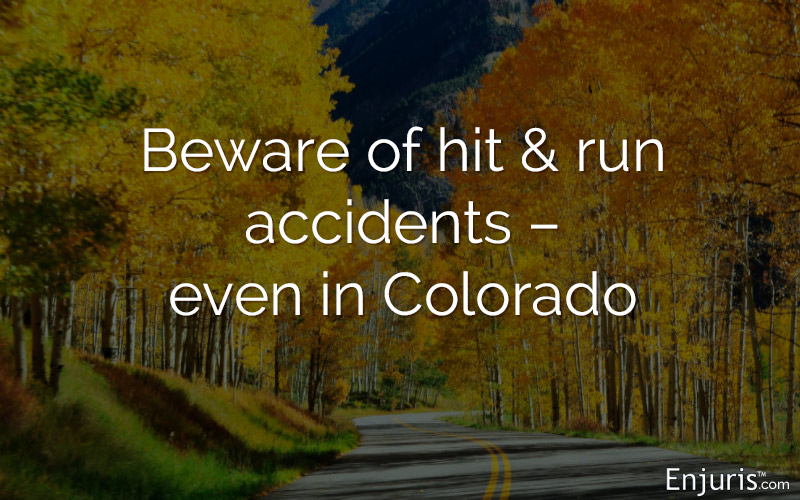What to do when a driver leaves the scene of a car accident
Hit and run accidents are a serious offense in Colorado. If a person leaves the scene of an accident, it could result in hefty fines or even imprisonment. Up to 1 in 5 car accidents in Colorado are hit and runs. Learn what to do and what not to do if you should find yourself in this unfortunate situation!
Colorado has so many wonderful attributes: beautiful greenery, friendly people, bustling industry… but for some reason, it also has very high hit and run accident statistics.
With its bike-friendly roads and athletic population, many people are impacted by motorists who are afraid of dealing with the consequences of their actions. As such, we are seeing a great number of hit and run accidents in the Centennial State.
A hit and run is when a driver hits another car, a person, an animal or property and fails to provide his or her insurance information or render aid before leaving the scene. In Colorado, this is a serious criminal charge that can range from a misdemeanor to a felony. Punishment can be everything from a fine all the way up to incarceration.
What responsibilities does a person have?
Under Colorado law, a driver has to stop and take certain actions after a crash that results in property damage or injury to another driver. In order to avoid the criminal charge of leaving the scene of an accident, a driver must stop, render aid to the victim if able, provide his or her personal information, and show a driver’s license upon request.
- With an accident that results in injury, if the driver flees without rendering aid, the result could be a Class 1 misdemeanor conviction, punishable by up to 18 months in jail and $5,000 in fines. If the victim’s injuries were serious, it could be a Class 5 felony punishable by 1 to 3 years in prison and fines reaching $500,000.
- In an accident that involves death, if the driver flees without rendering aid to a victim, it is a Class 3 felony punishable by 4 to 12 years in prison and fines reaching up to $750,000.
- In accidents involving property damage, it’s a Class 2 misdemeanor punishable by up to 1 year in jail and up to $1,000 in fines.
Why wouldn’t a driver stop?
There are many reasons why a driver would flee the scene of an accident.
- He is intoxicated or driving under the influence of drugs.
- He’s driving with a suspended license or has too many tickets.
- He doesn’t have a valid driver’s license.
- He doesn’t have car insurance.
- There is an outstanding warrant for his arrest.
- He might not have permission to drive the car or it’s stolen.
- He could be driving a company car and doesn’t want to get in trouble with his boss.
Don’t try to chase after the driver, even if you think you can catch him. That will result in you getting pulled over for speeding.
So what do I do?
Stay calm. Check on everyone in the car. State laws require that all drivers, not just the perpetrators, stay at the scene and call the police; this way, you can preserve the official record for your insurance company. Provide basic first aid and wait for emergency medical services to arrive. Try to get your vehicle toward the side of the road if possible.
Call the cops and emergency medical services. While you wait for them to arrive, collect information and see if you can find any evidence that will be significant to your insurance company.
A post-accident form should be kept in your glove compartment for times like these. It has all of the relevant information your insurance company will need for a claim. In this instance, filling it out will be one-sided. Take pictures on your phone of the accident scene, your car’s damage, the weather conditions and whatever else looks possibly relevant. Remember, it’s better to have too much rather than too little evidence.

Sample post-accident report form to keep in your glove box - fill out at the scene or as soon as you can after a car accident
Download in PDF format
Ask any witnesses what they saw and jot down their contact information – this is imperative. Witnesses can be very difficult to track down again.
For hit and run drivers, you have to be creative in trying to find them. Think of every piece of identifying information you can:
- Do you remember any of the license plate number? Even a few letters or numbers can help.
- What color was the car?
- Did it have rust?
- Was it broken down or brand new?
- Were there any identifying bumper stickers?
- Are there any nearby stores with video cameras?
- If the car was speeding, ask the police if there are any red camera lights to check.
Finally, contact your insurance company and file a claim.
Colorado’s Division of Insurance states that insurance companies have to offer uninsured motorist protection in an amount that’s equal to the bodily injury liability limits of the insured. The minimum amount of liability insurance coverage required in the state is $25,000 per person for bodily injury, $50,000 per accident for bodily injury, and $15,000 per accident for property damage.
However, that state minimum might not be enough to pay someone’s medical bills. That’s where underinsurance and uninsurance come in. These aren’t offered as standalone policies in Colorado and must be turned down in writing. These offset the cost of medical bills in case an uninsured or underinsured person injures you and can’t afford to pay your expenses.
Dealing with a hit and run driver is grueling. Hiring an attorney can be a fantastic way to get a lot of the work off your plate. Consider checking out Enjuris’ Colorado law firm listings.
See our guide Choosing a personal injury attorney.


